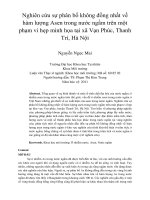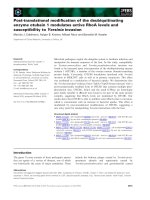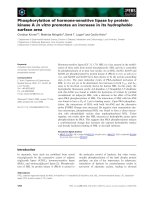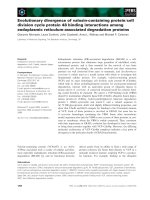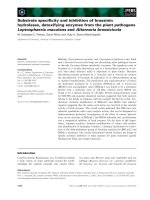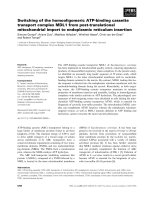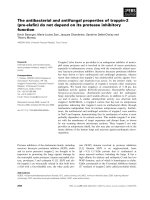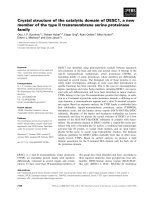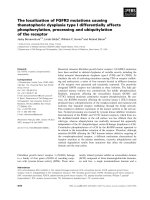BÁO CÁO KHOA HỌC: "Sử dụng cảm biến sinh học là vi khuẩn phát sáng đã biến đổi gen để khảo sát nhanh hàm lượng asen trong nước ngầm" ppt
Bạn đang xem bản rút gọn của tài liệu. Xem và tải ngay bản đầy đủ của tài liệu tại đây (213.81 KB, 24 trang )
Sử dụng cảm biến sinh học là vi khuẩn phát sáng đã
biến đổi gen để khảo sát nhanh hàm lượng asen trong
nước ngầm
Ô nhiễm Asen (thạch tín) trong nước uống bắt nguồn từ
nước ngầm được phát hiện tại nhiều khu vực trên thế giới,
nhất là tại các nước có mật độ dân cư cao như Ấn độ, Băng
la đet, Trung quốc và Việt nam. Để nhằm mục tiêu giảm
thiểu nhiễm độc Asen cho cộng đồng dân cư thì một trong
những bước quan trọng nhất là xác định sự ô nhiễm tại từng
giếng càng sớm càng tốt. Kỹ thuật mới sử dụng cảm biến
sinh học là vi khuẩn để xác định nhanh hàm lượng asen
trong nước ngầm có triển vọng hỗ trợ cho các phương pháp
phân tích truyền thống do các phương pháp phân tích hiện
trường hiện nay có độ chính xác không cao. Trong nghiên
cứu này cảm biến vi khuẩn phát sáng Escherichia coli DH
5 (pJAMA8-arsR) đã được thí nghiệm để xác định asen
theo qui trình tối ưu. Để tránh sự hấp thụ asen bởi các
hydroxit sắt, các mẫu nước ngầm được axit hoá về pH 2
bằng HNO
3
(nồng độ cuối cùng là 0,015M). Một lượng
tương đương giữa mẫu và vi khuẩn trong môi trường LB
được trộn với nhau và được trung hoà lại bằng dung dịch
pyrophophat (nồng độ cuối cùng là 5mM). Thử nghiệm với
194 mẫu nước ngầm tại Việt nam cho thấy giới hạn phát
hiện của cảm biến sinh học này với các mẫu thực là 7 µg/l.
Các phép đo có độ chính xác khá cao trong khoảng nồng độ
10-100µg/l ( với r
2
=0.9). Kết quả này vượt trội hơn so với
các bộ kiểm tra hiện trường thông thường. Sai lệch âm và
dương là 8.0% và 2.4% khi dựa trên tiêu chuẩn về hàm
lượng asen trong nước ngầm của WHO ( 10µg/l) để xác
định mẫu có hay không ô nhiễm asen. Độ chính xác cao
của cảm biến sinh học thu được một phần nhờ các phép đo
luôn được lặp lại ba lần. Tốc độ thí nghiệm nhanh và độ
chính xác cao hứa hẹn sự ứng dụng rộng lớn của cảm biến
sinh học vi khuẩn trong sàng lọc sự ô nhiễm asen trên diện
rộng.
1. INTRODUCTION
Arsenic is polluting the groundwater at many places around
the world, like Bangladesh, West Bengal - India, Vietnam,
China, or Argentina, etc (Berg, 2001; Chakraborti, 2003
and Smedley 2002). Arsenic pollution is considered as the
most serious natural worldwide calamity of the present
moment. Around 150 million people in West Bengal and
Bangladesh, and over 2 million in China are exposed to
unacceptable health risks by consuming arsenic
contaminated drinking water. A similar situation may be
occurring in Vietnam, where arsenic is suspected to
potentially contaminate the tube wells of around 13.5
percent of the Vietnamese population, some 10.5 million
persons (Berg, 2001; UNICEF, 2002). Although a coarse
picture on the distribution of arsenic exists in the
groundwater in these affected areas, there are millions of
individual tube wells yet remaining to be measured
(Kiniburgh 2002, Chakraborti, 2003). Unfortunately,
arsenic is very heterogeneously distributed spatially, and
the arsenic contents in two nearby wells with 100 m in
distance can be as different as from 10 to higher 300 µg/L
(Berg, 2001, 2003; Smedley, 2002). It thus remains
absolutely necessary for effective arsenic mitigation
campaigns to screen every individual tube well (blanket
screening) and determine whether or not the quality of the
potable water complies with current arsenic guideline
values (for WHO 10 µg As/L, for Bangladesh currently 50
µg As/L).
Considering the poor technical facilities in the most
exposed countries, arsenic testing for a large number of
wells poses an extreme challenge. So far, mostly the
chemistry based commercial field test kits named Merck,
Hach, Arsenator, ANN, or local imitations have been
applied in Bangladesh, India, Vietnam and other countries
(Kiniburgh, 2002). Unfortunately, chemical field kits have
low precision, reproducibility and accuracy at arsenic
concentrations between 10 µg/L and 100 µg/L. For
example, among 290 wells tested both by field kits and
flow injection hydride generation atomic absorption
spectrometry (FI-HG-AAS), take into account the samples
with arsenic concentrations in the range of 50-100µg/L as
high as 68% of the samples measured by the field kits
scored false negative and 35% false positive (Rahman,
2002).
Quite a number of bacterial biosensors responsive to
different target compounds have been designed in the past
decade. Bacterial biosensors are genetically modified
bacteria that produce a reporter protein (such as bacterial
luciferase) in response to the presence of a target chemical.
Luminescent bacterial biosensors for arsenic measurement
have been developed recently as potential and promising
alternative methodologies (Daunert, 2000; Tauriainen
2000; Petänen, 2002; Van der Meer, 2004). Luminescent
bacterial biosensors for arsenite display a lower detection
limit of around 4 µg/L As(III) in potable water with
standard deviation of around ± 5%, which is more than
sufficient to comply with regulatory guidelines (Stocker,
2003).
Here a detailed protocol has been developed to measure
arsenic concentrations in Vietnamese groundwater pumped
from small-scale tube wells. The accuracy of the biosensor
used to predict arsenic concentrations at the guideline level
of 10 µg /L was determined by comparing with data
obtained simultaneously from AAS and AFS for the same
samples. Our results provide the first larger scale screening
of field samples with a biosensor-based test.
2. EXPERIMENTAL PROCEDURES
2.1. Groundwater sampling
194 groundwater samples from tube wells (family scale)
were sampled in villages located at arsenic affected areas of
the Red river and Mekong river delta, Vietnam.
Groundwater was collected at the tube by hand or electrical
pumping. Water was taken after 10 minutes pumping, when
the oxygen concentration in the water reached a stable
value, which was measured online by using a dissolved
oxygen electrode (PX 3000, Mettler-Toledo). 50mL
groundwater samples were filtered through 0.45µm filter
paper and transferred to acid-washed plastic bottles.
Samples were acidified to pH about 2 by addition 0.1mL
HNO
3
(7.5M, Merck) to final concentration of 0.015M.
Water bottles were transfer to the lab, stored at 4
o
C and
analysed for arsenic in two weeks.
2.2. Arsenic measurement by AFS and AAS
Arsenic in the groundwater samples was measured in
parallel by using an AAS-6800 (Shimadzu, Japan) at
CETASD’s laboratory, Hanoi University, Vietnam and an
AFS Millenium Excalibur (PS Analytical Ltd, Kent, U.K.)
at EAWAG, Switzerland. Calibration solutions were
prepared by using a stock solution of 1000 mg As(III)/L
(J.T Baker, Netherlands) and deionised water. Calibration
curves were established with final concentrations of 0, 1, 2,
4, 8 and 10 µg As/L (about 0, 0.013, 0.027, 0.053, 0.107
and 0.13 µM respectively). The data obtained by the two
methods were used to validate the Vietnamese AAS-
method, which was subsequently used to validate the
biosensor test. Standard reference materials as SPS-SW2
standard (Spectra pure Standard-Norway) and ICP Multi
element standard VI (Merck) were used to check the
accuracy of AAS and AFS methods.
2.3. Arsenic measurement by genetically modified E.
coli DH5 (pJAMA-arsR) biosensor
The arsenic biosensor was E. coli DH5 (pJAMA-arsR),
which was used under the cultivation and storage
conditions as described previously (Stocker, 2003). Briefly,
arsenite determination by the bacterial biosensor is based o-
n bioluminescence light produced by the cells in response
to arsenite contact. The intensity of the bioluminescence is
proportional to the arsenite exposition and can be recorded
after predefined incubation periods in a luminometer.
Biosensor cells carry a plasmid with the genes for bacterial
luciferase (luxAB) under expression control of the ArsR
transcriptional repressor protein. Cellular entrance of
arsenite causes release of transcriptional repression and
subsequent synthesis of luciferase by the cells. Arsenate is
spontaneously reduced by the cells to arsenite and hence
can also indirectly cause derepression and luciferase
synthesis (Daunert, 2000; Rosen, 2002; Stocker 2003,).
Biosensor assays were conducted in 4 ml sterilised glass
vials. The bacteria suspension was prepared just before the
assay by mixing a 1.3 mL frozen aliquot of biosensor cells
with 10 mL sterilised Luria-Broth (LB) medium. Equal
amounts of aqueous sample and cell suspension (500µL)
were pipetted per vial, vials covered with a screw cap and
incubated on a rotary shaker at 200 rpm and 30°C. After 90
minutes, 50 µl of n-decanal solution (18 mM in a 1:1 v/v
ethanol-water solution) was added to the vials as substrate
for the luciferase reaction. Light emission was recorded
after 3 minutes in a luminometer (Junior-Berthold,
Germany) and is expressed as relative light units (RLU).
Each sample was measured in triplicates, which were used
to calculate the average light emission. The response to
samples with unknown arsenic concentrations was
compared to that of a standard series of arsenite
concentrations, containing 0, 0.1, 0.2, 0.4, 0.8 and 1µM As
(0, 7.5, 15, 30, 60 and 75 µg As/L) and prepared in arsenic-
free groundwater. Arsenic concentrations in unknown
samples were determined by linear interpolation of the
standard curve. In case of acidified samples, 25 µL of a
200mM sodium pyrophosphate solution (Na
4
P
2
O
7.
10 H
2
O,
Sigma) was added per 500µL groundwater sample in situ to
the test vial. All experiments were carried with triple
measurement and used for average calculation.
3. RESULTS AND DISCUSSION
3.1. The protocol for determination of As in
groundwater by genetically modified E. coli DH5
(pJAMA-arsR) biosensor
The most optimal combination found is acidification
groundwater to pH 1.8-2.0 by addition of HNO
3
to
concentration of 0.015mM, the acidified groundwater
sample then was mixed with LB solution contained
bacterial biosensor by ratio 1:1, the suspension was
subsequent added in situ pyrophosphate (5 mM final
concentration) to readjust the pH to about neutral. This
protocol was described at Figure 1 and subsequently
followed by all field samples.
Figure 1: Flow chart for biosensor test
3.2. Rapid screening of field samples with the bacterial
biosensor.
Firstly the reference method for total arsenic determination
by AAS at CETASD in Vietnam was validated by
comparison with the AFS method performed at the
EAWAG in Switzerland on a set of 111 groundwater
samples collected in Mekong river delta, Vietnam (Fig. 2).
A linear correlation between the AAS and AFS data was
calculated by regression analysis. Linearity with r
2
-values
equal 0.99 were obtained, hence giving confidence that the
AAS method at the CETASD would give a proper
calibration for comparisons to the biosensor obtained
values afterwards.
Chemical compositions of groundwater at Vietnamese
arsenic contaminated areas are quite variety as present at
Table 1 (internal data). Arsenic, iron, bicarbonate,
phosphate, ammonium, chlorite, etc concentrations are
different as from 10 to 1000 times between sampling
points. This hence is challenge for the application of
biosensor as arsenic test device because living bacteria cells
are used. Response of biosensor to dissolved arsenic in
groundwater was checked using concentrations from 0 to 3
µM (0 - 225µg/L). The groundwater matrix is arsenic free
and 0.18mM of iron (20mg/L). As present in Figure 3a the
curve was linear in the range of 0 to 1µM with r
2
-values
equal 0.99, above this concentration bacteria response to
arsenic was not linear and became saturate when
concentration of arsenic reach about 3 µM (Figure 3b). The
results were agreed with data described before for this E.
coli DH5α (pJAMA-arsR) biosensor (Stocker, 2003).
Assuming that detection limit is value equal to 3 times of
standard deviations measured by blank samples, here it was
seen as 0.1µM arsenic (7.5 µg/L). The sensitivity of the
biosensor is adequate to identify arsenic concentration in
groundwater as low as 10 µg/L, which is recommended
value from WHO for arsenic criteria in drinking water.
Figure 2: Cross checking for arsenic determination by
AAS (CETASD) and AFS (EAWAG)
AAS and the biosensor assay were then used
simultaneously at CETASD to measure arsenic levels in
194 groundwater samples that were collected in July 2004
from the Red River and Mekong delta region. Biosensor
response to unknown samples was compared to a standard
curve prepared in arsenic-free groundwater with the range
of 0, 0.1, 0.2, 0.4, 0.8 and 1µM arsenic, standard and
unknown samples always were prepared and measured at
the same batch. Of all samples two fold dilutions were
measured as described at protocol (Figure 1). A
comparative plot of all values gathered by AAS and
biosensor showed a good correlation between both methods
at Figure 4a, especially at the low concentration from 0.1 to
1µM (r
2
= 0.88) at Figure 4b. Practically by AAS method,
water samples with arsenic levels from < 0.1µM to < 1µM
were diluted 10 time, and 100 time for higher 1µM, but o-
nly two time dilution was applied for biosensor test. That
could be the reason for lower response at biosensor for
samples with arsenic level higher than 2µM. As show at
Figure 3, the bacteria biosensor could only give the linear
response at concentrations from 0 to 1µM, here with the
samples contain exceed 2µM of arsenic the plot was not
straight anymore and become saturated and even go down
when arsenic concentration is higher than 4µM (300 µg
As/L), that might be toxic levels for bacteria. Since the
biosensor measures rather accurately in the lower range of
arsenic concentrations (10-100 µg As/L) it has an important
advantage over most other field kits at present. Assuming
that the data obtained by AAS had a higher probability for
being true, the comparative false positive and false negative
results obtained by the biosensor assay were calculated in
Table 2 for arsenic concentrations in the range of smaller
than 10, from 10 to 100 and higher than 100 µg As/L.
Table 1: Some chemical compositions of groundwater at
Vietnam
The biosensor prediction was calculated for false negative
(identifying a sample as lower than the set value, for
example drinking water standard with10 µg As/L, when its
true concentration by AAS is exceeding), and false positive
(identifying as exceeding the set value when it is less).
Both of these false identities are important, the false
negative will mark a well as safe but actually it is not safe,
this subsequently bring people to the health risk. The false
positive will mark a well as not safe then should be closed
for example, but actually it is safe for use, it is major social
economic impact (Rahman, 2002). Among total 194 tested
samples, 112 samples (57.7%) determined as safe with
lower than 10 µg/L arsenic, 38 samples (19.6%) contained
arsenic concentration from 10 to 100 µg/L and 44 samples
(22.7%) above 100 µg/L arsenic. At level lower than 10
µg/L, 9 samples were false negative (8.0%) with arsenic
levels from 10 to 19 µg/L, it means that arsenic
concentrations of the false negative samples were not
exceeded very much but still is the safety level of some
other countries as Bangladesh (50 µg/L). With 38 samples
identified in between 10 and 100 µg/L of arsenic, 5 samples
(13.1%) were recorded as false negative with arsenic levels
in the range of 142 - 176 µg/L and 2 samples (5.3%) were
false positive. For 44 samples were determined as
contained higher than 100 µg/L of arsenic non of them was
false negative and one sample (2.3%) was false positive
with true value as 97 µg/L, that is very closed to 100 µg/L,
this discrepancy could also happen between modern
instrument tests (Kiniburgh, 2002). In summary, if all the
wells were categorised as safe or not safe base on the
recommended value of WHO for arsenic in drinking water
(10µg/L), data recorded as 9 samples among 112 samples
were false negative (8.0%) and 2 samples among 82
samples were false positive (2.4%).
Table 2: False negative and false positive values of
Biosensor compared with AAS
In light of the horrifying high rate of false negatives with
chemical field test kits of up to 68% at arsenic
concentrations in the range of 50 to 100 µg/L (Rahman,
2002), the performance of the biosensor assay is very
promising. Validation with more real samples and more
dilution with high arsenic contaminated samples will
definitively lead to an even better idea on the accuracy of
the biosensor measurements for samples with a variety of
different chemical composition, but we are confident that
assay using the luminescent bacterial strain E. coli DH5
(pJAMA-arsR) can be an important new tool for rapid
screening of arsenic in groundwater. The test could be
performed as arrays in 96 wells tray with triple
measurement for each sample ensuring its accuracy.
Average through put sample for 96 wells and single vial
testing is 100 and 50 samples per day respectively in our
lab. Likewise, similar biosensor strains selective to other
chemical target compounds may herald a relatively easy
and rapid tool for screening.
4. CONCLUSION
Our study developed a suitable protocol using the
luminescent genetically modified strain E. coli DH5
(pJAMA-arsR) for rapid screening of arsenic in
groundwater especially in iron rich media, which is
common at many high-risk areas in the world. The
biosensor showed very good accuracy at critical range of
arsenic concentration (10-100 µg/L) with r
2
equal 0.9. Over
all ratios for false negative and positive are 8.0% and 2.4%
respectively base on standard value of 10 µg/L arsenic.
Their high sample through put and high accuracy with
triple measurement is worth to continue the validation by
more real samples before it can be fulfil for mass screening.
Acknowledgments
This study was funded by the Swiss Agency for
Development and Cooperation (SDC) in the frame –work
of the Swiss-Vietnamese Cooperation Project ESTNV
(Environmental Science and Technology in Northern
Vietnam). We are particularly grateful to the involved
staffs at CETASD, Vietnam and EAWAG, Switzerland for
their contributions.
REFERENCES
1. Berg; H. C. Tran; T. C. Nguyen; H. V. Pham; R.
Schertenleib; W. Giger. (2001). Arsenic contamination of
groundwater and drinking water in Vietnam: A human
health threat. Environ. Sci. Technol., 35, 2621-2626.
2. Chakraborti, D.; Mukherjee, S. C.; Pati, S.,;Sengupta,
M., K.; Rahman, M. M.; Chowdhury, U. K.; Lodh, D.;
Chanda, C. R.; Chakraborti, A. K.; Basu, G. K. (2003)
Arsenic Groundwater Contamination in Middle Ganga
Plain, Bihar, India: A future Danger? Environmental health
perspectives. 111, 1194-1201.
3. Daunert, S.; Barrett, G.; Feliciano, J. S.; Shetty, R. S.;
Shrestha, S.; Smith-Spencer, W. (2000) Genetically
Engineered Whole-Cell Sensing Systems: Coupling
Biological Recognition with Reporter Genes. Chem. Rev.
100, 2705-2738
4. Kinniburgh, D. G.; Kosmus, W. (2002) Arsenic
contamination in groundwater: some analytical
considerations. Talanta 58, 165-180.
5. Petänen, T; Romantschuk, M. (2002). Use of
bioluminescent bacterial sensors as an alternative method
for measuring heavy metals ion soil extracts. Analytica
Chimica Acta 456, 55-61.
6. M. M. Rahman; D. Mukherjee; M. K. Sengupta,;U. K.
Chowhudry; D. Lodh; C. R. Chanda; S. Roy; M. Selim; Q.
Quamrussaman; A. H. Milton; S.H. Shahidullah; M. T.
Rahman; and D. Chakraborti. (2002). Effectiveness and
reliability of arsenic field testing kits: Are the million dollar
screening projects effective or not? Environ. Sci. Technol.,
36, 5385-5394.
7. Smedley, P. L. and Kinniburgh, D. G. (2002). A review
of the source, behaviour and distribution of arsenic in
natural waters. Applied Geochemistry, 17 (5), 517-568.
8. Stocker, J.;Balluch, D.; Gsell, M.; Harms, H.; Feliciano,
J.; Daunert, S.; Malik, K. A.; van der Meer, J. R. (2003)
Development of a set of simple Bacterial Biosensor for
quantitative and rapid measurements of arsenite and
arsenate in potable water. Environment Science
Technology 37, 4743-4750.
9. Tauriainen, S. M.; Virta, M. P. J.; Karp, M. T. (2000)
Detecting bioavailable toxic metal and metalloids from
natural water samples using luminescent sensor bacteria.
Wat. Res., 34, 2661-2666.
10. UNICEF Vietnam (2002) Arsenic Contamination:
Vietnam's Pathway to Alleviation. Water, Environment and
Sanitation Section
11. Van der Meer, J.R.; Tropel, D.; Jaspers, M. (2004).
Illuminating the detection chain of bacterial biorepoters.
Environmental Microbiology, 6(10), 1005-1020.
